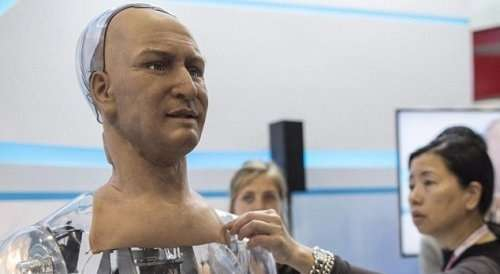 At the Global Sources spring electronics show in Hong Kong, a robot was presented that very accurately imitates human facial expressions. This is a development by Hanson Robotics. Previously, the company's founder, engineer David Hanson, had already presented several "live faces" to the public. One of the models was a very realistic Albert Einstein. But the latest development, Han, surpasses previous works in its facial expression capabilities. Hanson Robotics adds more motors and servos to each new robot, which allows for a significant expansion of the range of emotions. At the moment, Han uses a material called Frubber (flesh rubber) to reproduce realistic skin.
Creating an artificial human face is one of the important tasks of modern robotics. While machines are learning to walk on two legs and imitate humans in communication, many developers from all over the world are trying to give them a realistic appearance. So far, Japanese professor Hiroshi Ishiguro has succeeded quite well in this. The company he founded, Hiroshi Ishiguro Laboratories, is well known in the world for its line of Geminoid robots. The robots have male and female versions. From a certain distance, they can indeed be mistaken for a person. However, the degree of freedom of the machines is severely limited. Thus, the most expensive and advanced model, Geminoid HI-2, can perform 50 movements, 13 of which are facial expressions.
Toshiba is slightly behind in terms of performance. Their humanoid robot with a human face, ChihiraAico, has 43 drives built in. Facial expressions are also controlled by 13 of them. Why don't scientists add more drives? They simply do not fit on the "face", which means that it is not yet possible to reproduce the actions of dozens of facial muscles.
Considering this, developers from the UK decided to approach the problem from a completely different angle. They completely abandoned the use of engines and artificial skin. Last year, Engineered Arts presented its unusual project SociBot-Mini. It is a robotic head with a face made of translucent plastic. The plastic has approximate contours of a human face. Inside the head there is a powerful projector that projects an image of the face onto the outer surface. The uniqueness of this approach is the ability to instantly change appearance. The robot can instantly imitate the face of any person of the appropriate build. Age, skin color, and even gender do not matter to SociBot-Mini. The main thing is that the fullness and shape of the skull are approximately the same. Minor individual differences are easily hidden with shades and shadows.
A similar project Mask-bot was presented back in 2011 by the Institute of Cognitive Systems at the University of Munich (Germany). Then, an animated human face was also projected onto a motionless translucent mask. This approach has its advantages and disadvantages. First of all, the face created with the help of the projector glows. It conveys small facial expressions, such as slight movements of the eyebrows or eyelids, much better than a bulky structure made of rubber and pneumatic drives. On the other hand, with this approach, it is better to avoid demonstrating strong emotions. For example, if you raise your eyebrow too high or open your mouth too wide, no amount of shadow play will hide the projection. Professor Gordon Chen, one of the creators of Mask-bot, believes that the best result can be achieved if in the future it is possible to combine a moving surface and projection.
At the Global Sources spring electronics show in Hong Kong, a robot was presented that very accurately imitates human facial expressions. This is a development by Hanson Robotics. Previously, the company's founder, engineer David Hanson, had already presented several "live faces" to the public. One of the models was a very realistic Albert Einstein. But the latest development, Han, surpasses previous works in its facial expression capabilities. Hanson Robotics adds more motors and servos to each new robot, which allows for a significant expansion of the range of emotions. At the moment, Han uses a material called Frubber (flesh rubber) to reproduce realistic skin.
Creating an artificial human face is one of the important tasks of modern robotics. While machines are learning to walk on two legs and imitate humans in communication, many developers from all over the world are trying to give them a realistic appearance. So far, Japanese professor Hiroshi Ishiguro has succeeded quite well in this. The company he founded, Hiroshi Ishiguro Laboratories, is well known in the world for its line of Geminoid robots. The robots have male and female versions. From a certain distance, they can indeed be mistaken for a person. However, the degree of freedom of the machines is severely limited. Thus, the most expensive and advanced model, Geminoid HI-2, can perform 50 movements, 13 of which are facial expressions.
Toshiba is slightly behind in terms of performance. Their humanoid robot with a human face, ChihiraAico, has 43 drives built in. Facial expressions are also controlled by 13 of them. Why don't scientists add more drives? They simply do not fit on the "face", which means that it is not yet possible to reproduce the actions of dozens of facial muscles.
Considering this, developers from the UK decided to approach the problem from a completely different angle. They completely abandoned the use of engines and artificial skin. Last year, Engineered Arts presented its unusual project SociBot-Mini. It is a robotic head with a face made of translucent plastic. The plastic has approximate contours of a human face. Inside the head there is a powerful projector that projects an image of the face onto the outer surface. The uniqueness of this approach is the ability to instantly change appearance. The robot can instantly imitate the face of any person of the appropriate build. Age, skin color, and even gender do not matter to SociBot-Mini. The main thing is that the fullness and shape of the skull are approximately the same. Minor individual differences are easily hidden with shades and shadows.
A similar project Mask-bot was presented back in 2011 by the Institute of Cognitive Systems at the University of Munich (Germany). Then, an animated human face was also projected onto a motionless translucent mask. This approach has its advantages and disadvantages. First of all, the face created with the help of the projector glows. It conveys small facial expressions, such as slight movements of the eyebrows or eyelids, much better than a bulky structure made of rubber and pneumatic drives. On the other hand, with this approach, it is better to avoid demonstrating strong emotions. For example, if you raise your eyebrow too high or open your mouth too wide, no amount of shadow play will hide the projection. Professor Gordon Chen, one of the creators of Mask-bot, believes that the best result can be achieved if in the future it is possible to combine a moving surface and projection.
 At the Global Sources spring electronics show in Hong Kong, a robot was presented that very accurately imitates human facial expressions. This is a development by Hanson Robotics. Previously, the company's founder, engineer David Hanson, had already presented several "live faces" to the public. One of the models was a very realistic Albert Einstein. But the latest development, Han, surpasses previous works in its facial expression capabilities. Hanson Robotics adds more motors and servos to each new robot, which allows for a significant expansion of the range of emotions. At the moment, Han uses a material called Frubber (flesh rubber) to reproduce realistic skin.
Creating an artificial human face is one of the important tasks of modern robotics. While machines are learning to walk on two legs and imitate humans in communication, many developers from all over the world are trying to give them a realistic appearance. So far, Japanese professor Hiroshi Ishiguro has succeeded quite well in this. The company he founded, Hiroshi Ishiguro Laboratories, is well known in the world for its line of Geminoid robots. The robots have male and female versions. From a certain distance, they can indeed be mistaken for a person. However, the degree of freedom of the machines is severely limited. Thus, the most expensive and advanced model, Geminoid HI-2, can perform 50 movements, 13 of which are facial expressions.
Toshiba is slightly behind in terms of performance. Their humanoid robot with a human face, ChihiraAico, has 43 drives built in. Facial expressions are also controlled by 13 of them. Why don't scientists add more drives? They simply do not fit on the "face", which means that it is not yet possible to reproduce the actions of dozens of facial muscles.
Considering this, developers from the UK decided to approach the problem from a completely different angle. They completely abandoned the use of engines and artificial skin. Last year, Engineered Arts presented its unusual project SociBot-Mini. It is a robotic head with a face made of translucent plastic. The plastic has approximate contours of a human face. Inside the head there is a powerful projector that projects an image of the face onto the outer surface. The uniqueness of this approach is the ability to instantly change appearance. The robot can instantly imitate the face of any person of the appropriate build. Age, skin color, and even gender do not matter to SociBot-Mini. The main thing is that the fullness and shape of the skull are approximately the same. Minor individual differences are easily hidden with shades and shadows.
A similar project Mask-bot was presented back in 2011 by the Institute of Cognitive Systems at the University of Munich (Germany). Then, an animated human face was also projected onto a motionless translucent mask. This approach has its advantages and disadvantages. First of all, the face created with the help of the projector glows. It conveys small facial expressions, such as slight movements of the eyebrows or eyelids, much better than a bulky structure made of rubber and pneumatic drives. On the other hand, with this approach, it is better to avoid demonstrating strong emotions. For example, if you raise your eyebrow too high or open your mouth too wide, no amount of shadow play will hide the projection. Professor Gordon Chen, one of the creators of Mask-bot, believes that the best result can be achieved if in the future it is possible to combine a moving surface and projection.
At the Global Sources spring electronics show in Hong Kong, a robot was presented that very accurately imitates human facial expressions. This is a development by Hanson Robotics. Previously, the company's founder, engineer David Hanson, had already presented several "live faces" to the public. One of the models was a very realistic Albert Einstein. But the latest development, Han, surpasses previous works in its facial expression capabilities. Hanson Robotics adds more motors and servos to each new robot, which allows for a significant expansion of the range of emotions. At the moment, Han uses a material called Frubber (flesh rubber) to reproduce realistic skin.
Creating an artificial human face is one of the important tasks of modern robotics. While machines are learning to walk on two legs and imitate humans in communication, many developers from all over the world are trying to give them a realistic appearance. So far, Japanese professor Hiroshi Ishiguro has succeeded quite well in this. The company he founded, Hiroshi Ishiguro Laboratories, is well known in the world for its line of Geminoid robots. The robots have male and female versions. From a certain distance, they can indeed be mistaken for a person. However, the degree of freedom of the machines is severely limited. Thus, the most expensive and advanced model, Geminoid HI-2, can perform 50 movements, 13 of which are facial expressions.
Toshiba is slightly behind in terms of performance. Their humanoid robot with a human face, ChihiraAico, has 43 drives built in. Facial expressions are also controlled by 13 of them. Why don't scientists add more drives? They simply do not fit on the "face", which means that it is not yet possible to reproduce the actions of dozens of facial muscles.
Considering this, developers from the UK decided to approach the problem from a completely different angle. They completely abandoned the use of engines and artificial skin. Last year, Engineered Arts presented its unusual project SociBot-Mini. It is a robotic head with a face made of translucent plastic. The plastic has approximate contours of a human face. Inside the head there is a powerful projector that projects an image of the face onto the outer surface. The uniqueness of this approach is the ability to instantly change appearance. The robot can instantly imitate the face of any person of the appropriate build. Age, skin color, and even gender do not matter to SociBot-Mini. The main thing is that the fullness and shape of the skull are approximately the same. Minor individual differences are easily hidden with shades and shadows.
A similar project Mask-bot was presented back in 2011 by the Institute of Cognitive Systems at the University of Munich (Germany). Then, an animated human face was also projected onto a motionless translucent mask. This approach has its advantages and disadvantages. First of all, the face created with the help of the projector glows. It conveys small facial expressions, such as slight movements of the eyebrows or eyelids, much better than a bulky structure made of rubber and pneumatic drives. On the other hand, with this approach, it is better to avoid demonstrating strong emotions. For example, if you raise your eyebrow too high or open your mouth too wide, no amount of shadow play will hide the projection. Professor Gordon Chen, one of the creators of Mask-bot, believes that the best result can be achieved if in the future it is possible to combine a moving surface and projection.





